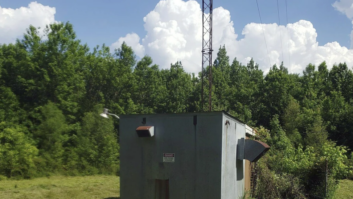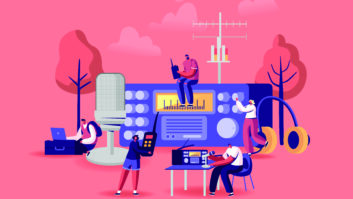Here is the unedited speech by FCC Chairman Ajit Pai at the 2017 Radio Show in Austin, Texas, Sept. 6, 2017.
Thank you, Senator Smith, for that kind introduction, and to all of you for that warm welcome. It’s an honor to keynote this year’s Radio Show Luncheon. And congratulations to David Field for the well-deserved honor of receiving the National Radio Award.
Whenever I meet with broadcasters like you, I always make a point of highlighting the importance of over-the-air radio and television, and expressing my gratitude for all that you do for your communities and our country. This has never been more timely and warranted than it is today.
As everyone in Texas knows, Hurricane Harvey was one of the most devastating storms in U.S. history. It poured over 25 trillion gallons of water into the region, causing flooding unlike anything we’ve ever seen. So many Americans have lost so much, including the tragic loss of dozens of lives. My thoughts and prayers are with those struggling as we speak to put their lives back together.
But as saddened as I am by Harvey’s destruction, the past week’s events have also left me heartened and hopeful. Once again, we saw that the worst of tragedies brings out the best in the American people.
We saw first responders rushing into danger. That includes Sergeant Steve Perez of the Houston Police Department. He left his home at 4:00 a.m. on Aug. 27 to report to his duty post in downtown Houston and tragically drowned in his patrol car while driving to help those impacted by the storm.
We saw the Coast Guard rescue over 11,000 people. That includes pilot Jason Brownlee, who left his own flooded home after getting a 3:00 AM call from his superiors and ultimately saved almost two dozen Texans.
We saw hundreds of people open up their property to strangers who needed a place to stay. That includes a furniture-store owner — known as “Mattress Mack” — who sheltered 800 people in his two showrooms.
We saw Houston Texans star J.J. Watt start a relief campaign hoping to raise a few hundred thousand dollars. The campaign has currently raised over $21 million.
We saw fleets of private citizens in their boats patrolling flooded streets and delivering people on rooftops to safety. That includes the famous folks from Louisiana who came to help, declaring themselves the vanguard of the “Cajun Navy.”
And, yes, we saw the FCC’s best out in the field. I personally want to thank our agents who went out in the storm to monitor damage to our communications networks. Yesterday in Houston, I also had the chance to survey the damage Harvey has left behind and meet with officials at the Greater Harris County 9-1-1 Center, where so many calls for help were answered.
But you can’t talk about the heroes of Hurricane Harvey without talking about broadcasters.
Station after station scrapped commercials and promos to provide nonstop, wall-to-wall emergency information and news. Some radio stations literally went above and beyond. CBS Radio’s KIKK in Pasadena, Texas, usually broadcasts only in the daytime, but it petitioned the FCC for authority to provide emergency information around-the-clock. We were happy to grant that request within one hour. You heard stories of producers and engineers spending night after night at their stations so they could stay on the air with the crucial information audiences needed, like which grocery stores were open and whether or not they still had bottled water. You also had on-air talent coming in just to answer phones and lend support where they could.
Radio broadcasters were using every resource at their disposal to keep people connected to information and each other. Popular DJs like Nick Russo of 100.3 The Bull blasted out a steady stream of storm updates on Twitter to tens of thousands of followers. iHeartMedia leveraged its billboard assets to direct residents to emergency information and worked directly with the Red Cross to coordinate post-storm relief efforts. And, as millions now know, one broadcaster even helped save a truck driver on live television. I know she’s on the TV side, but you’ve got to tip your cap on that one. Brandi Smith of KHOU — bravo!
I’m in awe of broadcasters’ response to Harvey. But I’m not surprised. Because that’s what broadcasters do. You go above and beyond to be there for your communities. That’s true anytime, but especially in times of crisis. As one station GM put it, “Radio is the ultimate connector.” The spirit of service and community we saw so publicly on display during this devastating storm, and throughout its aftermath, is in your DNA. I think that’s a big reason why 93% of Americans still regularly tune in to radio. And that’s why, during Harvey, an enormous number of people relied on radio to get critical emergency information. Consider this: NextRadio reports that on August 25, when Harvey made landfall in Corpus Christi, local NextRadio app listening was up 186% as compared to an average Friday. Similar findings were reported for listeners in Houston. Even in this age of high-speed connectivity, radio still has a unique connection with the audience that isn’t going away.
We at the FCC want to do what we can to help you deepen that connection. It may be in the weeds, and it certainly isn’t as inspiring as the stories I just relayed, but I’m pleased to give a status report on some of our efforts.
First up is one of the first issues I set my sights on five years ago when I became a commissioner: AM revitalization. This audience knows the broad strokes of this issue, largely because you were vital to getting the first AM revitalization order adopted back in 2015. So I’ll spare you any background and get straight to the most recent developments.
As you know, the centerpiece of our reforms to date has been helping AM broadcasters get FM translators. So far, the response has been tremendous. Last year, the FCC gave AM stations more latitude to move an FM translator purchased on the secondary market. We received nearly 1,100 applications and granted almost 95% of these requests.
Back in 2015, some folks argued that secondary market windows for translators would be sufficient to meet the AM stations’ demand. I disagreed, and successfully pushed back. Judging by the response we received this summer, I’m sure glad that I did.
During the recently completed 2017 window for new AM translators, we once again received more than 1,000 applications from AM broadcasters. That brings the total number of applications received to about 2,100, or nearly half of all licensed AM stations nationwide.
This recently closed window was for Class C and D stations only. The majority of applications — 698 to be exact — came from Class D AM stations. Many of these are daytime stations that don’t broadcast at night. Translators will enable them to operate on a full-time basis. That could be a lifeline, as I heard from a former daytimer in Kansas years ago whose ad revenues and listenership jumped after he found a translator.
Our Audio Division’s talented staff is currently reviewing all of the translator applications that were filed this summer. I’m optimistic that we’ll have good news to report in the near future.
Now, in that same AM revitalization order, we also reduced regulatory burdens on AM broadcasters and teed up additional proposals for lowering costs and improving signal quality. Today, I am pleased to announce that the commission is beginning to move forward on those proposals. Specifically, at our September meeting, we will vote on an order that would relax certain technical rules applicable to AM broadcasters operating directional antenna arrays in order to ease the regulatory and financial burdens faced by these broadcasters. The order is highly technical, so I’m not going to go into the details here. But because of the new transparency that we have brought to the FCC, tomorrow you will be able to see for yourself the draft order that I’ve shared with my colleagues.
Reducing burdens on broadcasters is a natural segue to my next topic: our across-the-board review of our media rules.
Back in May, the FCC launched a comprehensive review of our media regulations. Our goal is simple: let’s modernize our rules to match the realities of today’s marketplace. This better promotes the public interest and allows for more competition, innovation, and investment in the media sector. We asked for your thoughts on which rules should be modified or repealed as part of this review, and why. And we received plenty of feedback.
When we came up with the idea for this proceeding, we thought of it as a way for us to clean out the regulatory underbrush. And as is the case with many ranches right here in Texas, there’s plenty of underbrush to be cleared among the 1,000 or so pages of FCC media rules. It’s time for us to get to work.
For the foreseeable future, I will therefore be sharing with my fellow commissioners each and every month at least one Notice of Proposed Rulemaking teeing up outdated or unnecessary media regulations that should be eliminated or modified. And even though the deadline for public input only passed a few weeks ago, our September commission meeting will feature the first action item to come out of this effort.
Under the FCC’s rules, certain broadcast and cable entities are required to maintain physical copies of commission rules in their offices. I’m talking about actual volumes of the Code of Federal Regulations. Now, in the grand scheme of things, I understand that this is hardly the biggest deal. But it offers a pretty vivid example of how there are outdated regulations that are still on the books that no longer make any sense. And in this case, the rule in question actually involves books of regulations! That’s why I circulated to commissioners today a proposal to get rid of this requirement. In the digital age, when anyone can easily access the FCC’s rules online, this rule isn’t necessary anymore.
Speaking of unnecessary and outdated rules, earlier this year, the FCC proposed to eliminate our main studio rule. As you probably know, decades ago, the agency required each AM, FM, and television broadcast station to maintain a main studio located in or near its community of license. The original idea was that local access to a station’s main studio was necessary for the public to give broadcasters their input and to review a station’s public inspection file.
But the reality is that local access to a physical station is simply no longer necessary to satisfy those public interest goals. Broadcasters’ public inspection files are either currently available or will soon be available online. And, if anyone in the community wants to contact their local station, such contact is much more likely to occur via social media, through email, or by phone.
On top of that, the rule is also undermining the public interest. For example, I heard from one broadcaster in Minnesota who said he wanted to build out his construction permit for an AM station in a nearby town. But he didn’t, because the “main studio rule is a killer; the cost to maintain a staff … would make the construction of this facility a ticket of doom.” And he isn’t alone, as broadcasters have made clear to the FCC.
As we say in our world, the record in this proceeding has now closed. After reviewing it, I’ve reached the conclusion that it is time for the rule to go. Therefore, this fall, I plan to ask my fellow Commissioners to vote on an order to repeal it.
Let’s shift gears for a minute. I’ve talked thus far about clearing away rules that unfairly burden radio broadcasters. But we also want to enforce the rules that protect those with licenses. Thanks in part to the vocal support of Commissioner O’Rielly, the FCC is substantially stepping up its enforcement efforts against pirate radio stations. Since I became chairman in January, the commission’s Enforcement Bureau has issued 55 Notices of Unlicensed Operation, several Notices of Apparent Liability, and six Forfeiture Orders against pirate broadcasters. We’ve cracked down on illegal operators all across the United States, from California to Kentucky, and up and down the East Coast from Florida to Massachusetts. You can rest assured we will not just continue, but intensify this effort in the months to come. Our message to pirate operators is clear: the FCC will not tolerate unauthorized, illegal broadcasts, and we will use all of the tools within our disposal to end them.
I’ll close with this. The location of this year’s show is fitting. And that’s not just because of broadcasters’ heroic work during Harvey. Texas — and Austin in particular — has given us some of the nation’s most notable moments in broadcasting and memorable broadcasters. For instance, KTBC here in Austin gave a local high school graduate named Verne Lundquist one of his first breaks, and he went on to become the long-time radio voice of the Dallas Cowboys, not to mention making the call for two of sports most iconic showdowns — Nancy Kerrigan vs. Tonya Harding at the 1994 Winter Olympics and Shooter McGavin vs. Happy Gilmore. And in November 1921, what may have been the first broadcast of a football game in America aired over call sign 5XB from the Agricultural and Mechanical College — what’s now Texas A&M. (I’ve actually visited that station, which is now WTAW. I don’t know if it covered A&M’s most recent game, the stunning collapse against UCLA. But if it did, that may have been the last football broadcast out of College Station.)
And it turns out that one of the most iconic broadcasters of the last century, Walter Cronkite, has local ties as well. He went to high school in Houston and college right here at UT-Austin, writing for the Daily Texan. He broke into broadcasting as a radio man, calling college football games for KCMO in Kansas City using Western Union telegraph dispatches. I daresay that Cronkite provided the right words for this moment and your industry. He said, “Success is more permanent when you achieve it without abandoning your principles.” Like every part of our society and economy, radio has been disrupted by new digital technologies. But it’s enduring and thriving today because your success is rooted on such sound principles: localism, diversity, community, and public service. To borrow from Cronkite again, “that’s the way it is on Wednesday, Sept. 6, 2017.” And that’s the way I hope it will be.











